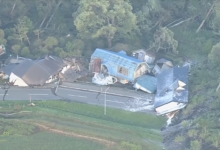In response to the pollution crisis in the Quintero and Puchuncavi region at the end of August that gave 358 people toxic poisoning, the Ministry of the Environment has announced a five-point decontamination plan.
Environment Minister Carolina Schmidt gave details on the plan which was published on the Ministry of the Environment portal, assuring that the government’s highest priority is the health of its citizens. The plan aims to combat long-standing pollution issues plaguing the heavily industrialised Quintero and Puchuncavi coastal region 100 kilometres northwest of Santiago.
Comparto con ustedes las 5 medidas concretas que impulsaremos en Quintero-Puchuncaví. Estas medidas forman parte de un plan integral de descontaminación e invitamos a todas las empresas a sumarse ¡Lo más importante es la salud de las personas!
DECLARACIÓN PÚBLICA ⤵️ pic.twitter.com/kEq29jSO5q— Carolina Schmidt (@CarolaSchmidtZ) 6 de septiembre de 2018
The first point Schmidt explained was that from Sept. 10, the entire network of air-quality monitoring systems, which currently depend on the region’s businesses, will be placed under the Chilean state’s direct supervision. “This guarantees that all the inhabitants of the communities will have an independent and transparent monitoring system,” she said.
Further down the line, she added in her second point, in the second trimestre of 2019 the Ministry of the Environment will take part in an international conference with the Finnish government. Schmidt implied that Finland would help supply the South American country with the necessary equipment and technology for a state-of-the-art environmental monitoring system.
Thirdly, Schmidt announced the creation of a “more demanding air-quality regulations for sulphur dioxide,” which would be implemented from the first semester of 2019 and would conform to international standards. As well as this, for the first time the country will execute an hourly measurement of sulphur dioxide, whereas the current measurement only takes place every 24 hours.
From Oct. 1, Schmidt continued, the companies AES Gener and Codelco, who are both situated in the Quintero and Puchuncavi area, will have to bring their operational plans up to date. This will involve adjustments to their daily ventilation systems. “This is to say, if the ventilation conditions are unfavourable, its activity will reduce. As the Ministry of the Environment, we make a call to all companies present in this zone to form part of this plan,” Schmidt added.
The last of the five points will come into being on Dec. 5 and will place more requirements on all of the companies that function in the industrial zone in accordance with the new Decontamination Plan.
This Decontamination Plan was elaborated by President Sebastián Piñera’s government in response to the recent event that placed 19 people in hospital and provoked widespread protests.
ENAP, the company allegedly behind the release of pollutants at the end of August, have publicly denied any involvement through communiques on their website.
Cristián Franz, the superintendent of the Ministry of the Environment told BioBioChile that the contamination purportedly created by the company was of high intensity but short duration, meaning that “there is no longer any evidence” to accuse ENAP.
An investigation will take place into the company, but Franz expressed that he was not going to halt ENAPs production, instead inviting the company to provide evidence to prove that they are indeed innocent in the events.
“The sanctions process means that an investigating prosecutor should go forward with all the necessary proceedings to confirm who is responsible,” Franz told BioBioChile, adding that “All institutions, public or private, should fulfil the current environmental legislation […] Nobody is above the law.”









